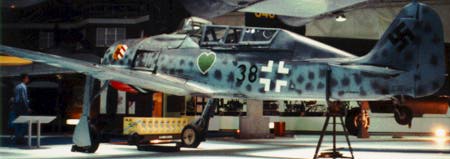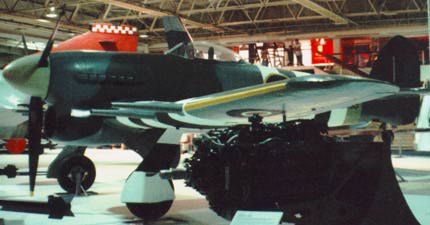
Updated: 1996/12/24 Tue

Fw190 The arrival of the Fw190 in WWII caused great consternation amongst the allies. British pilots had enjoyed a slight superiority in their Spitfires against the Axis Messerschmitts but found they were at a huge disadvantage against this newcomer. With high speed, an incredible roll rate and awesome firepower this aircraft became known as the "Butcher Bird" for good reason.
STATS: (Fw190A8)
Crew: 1 (trainer shown above) Service: 1941-1945 (Axis)
Max Speed: 355kt (653kph) @20,600'
Cruise Speed: 259kt (477kph) @23,000' Max Altitude: 37,400' (11.4km)
Max Range: 826nm (5,120km)
Climb: 32,800' in 16.5min
Armaments: 2 x 13mm MG 131 mg
4 x 20mm MG 151/20 cannon

Mosquito Also known as the "wooden wonder", the Mosquito was constructed primarily of plywood and canvas, and used in a variety of roles. Initial armament (not shown in this reconnaissance version) consisted of 4 x 20mm Hispano cannon and 4 x .303 Browning machine guns which packed a considerable punch. Other versions included a 57mm Bofors cannon for tank busting and attacking shipping convoys. Later versions were equipped with rocket projectiles on top of the machine guns and cannon and some could also carry bombs. Technically it was capable of limited dogfighting although it was predominantly used in an attack role.
STATS: (PR Mosquito XVI)
Crew: 2 (pilot/navigator) Service: 1943-1948? (Allies) Max Speed: 350kt (640kph) Max Range: 1,740nm (3,200km) Max Altitude: 36,000' (11.0km) Climb: ft/min Armaments: none for the photo-recon version

Typhoon Developed in the early stages of WWII the Typhoon was along a different design philosophy than it's partner, the Spitfire. An extremely sturdy airframe built around the most powerful British engine of the time it reminds one of the old adage that "given enough power even a brick can fly". Troubled by structural problems early in it's life when entire empannages would shear off for no apparent reason, the problem was eventually fixed and the Typhoon found life in the ground attack role. It's high speed also allowed it to deal with Fw190 interdiction raids into Britian when the Spitfire was hard pressed to catch the speedy Luftwaffe insurgents. The Typhoon spawned several other successful designs such as the Tempest and Sea Fury.
STATS: (Typhoon IB)
Crew: 1 (pilot) Service: 1942-1945 (Allies)
Max Speed: 350kt (640kph)
Armaments: 4 x 20mm Hispano cannon
2,000lb (900kg) on 2 hardpoints
various bombs and rocket projectiles

Spitfire and Hurricane The two workhorses for the British during the Battle of Britain (summer to fall of 1940), the Spitfire and Hurricane were complementary aircraft. Although the Spitfire is more renowned in actual fact the Hurricane had more operational aircraft during this time period. The Spitfire's speed and high altitude performance often found it pitted against the Luftwaffe's Bf109 fighter while the Hurricane intercepted the incoming bomber streams.
"Never in the field of human conflict was so much owed by so many to so few." --Winston Churchill
"He must be talking about our liquor bills." --unknown Canadian Spitfire pilot
